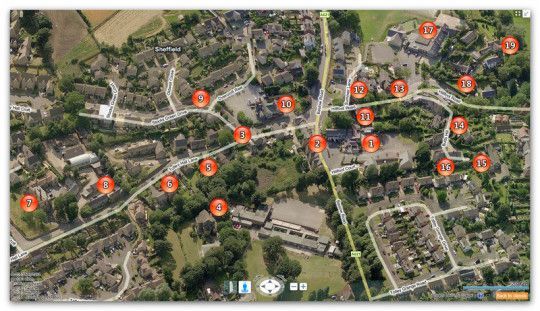The oldest part of the building faces Cross Grove House and is known to be more than 300 years old. When the turnpike road was built at the beginning of the 19th century, Samuel Hopkinson, a farmer and scythe maker, took the opportunity to open a pub. During the 18th and 19th centuries a stagecoach ran regularly between Sheffield, Bakewell and Buxton. The building to the left provided stabling for the horses used to pull the coaches. The Cross Scythes was also the terminus for the horse bus which ran from Dore & Totley station from 1885 until shortly before the First World War.
A Walk Around the Village

A Village Walk Map
The walk starts and ends at the The Cross Scythes, Baslow Road, S17 4AE, about 6 miles southwest of Sheffield on the A621 and a stopping point on bus route 97 from the city centre. There is a large car park for customers and guests only; otherwise on road parking nearby is available.
The short walk around the old part of the village is an easy-going 1½ miles and is suitable for wheelchair users. It links into a longer walk (3¼ miles in total) which includes a section on public footpaths across fields and which navigates a number of steps and stiles.
You may wish to refer to the maps in the associated Totley Village Walk Leaflet. This PDF file is a low resolution version of the leaflet and is available to view and download. It is in A3 portrait format but can be scaled to print at A4 size on a home printer.
It is an Adobe Acrobat document [1.6 MB]
1. Cross Scythes Baslow Road, north side
2. Grange Terrace Baslow Road, south side
3. Toft House Totley Hall Lane, east side
4. All Saints Church Totley Hall Lane, east side
5. Old Infant School Totley Hall Lane, east side
6. Totley Hall Lodge Totley Hall Lane, east side
7. Totley Hall corner of Totley Hall Lane and Totley Hall Croft
8. Totley Hall Farmhouse Totley Hall Lane, west side
9. Totley Well Stocks Green Drive, west side
10. Fleur de Lys Totley Hall Lane, west side
11. Cross Grove House Hillfoot Road, east side
12. Summer Lane off Hillfoot Road, west side
13. Hillfoot Road Cottages Hillfoot Road, west side
14. Ash Cottage Butts Hill, north side
15. Cannon Hall Butts Hill, north side
16. Shrewsbury Terrace Butts Hill, east end
17. All Saints School Hillfoot Road, west side
18. The Pinfold Hillfoot Road, west side
19. Totley Chapel off Chapel Lane, west side
This is the end of the short walk. You can either retrace your steps to the Cross Scythes or continue the walk down Chapel Lane for a further 2 miles. Please see 'A Longer Walk'.



















